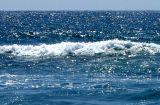El Niño is Back!
Written Sept. 2006.
El Niño, a weather pattern characterized by unusually warm water temperatures in the equatorial Pacific Ocean, has returned. The pattern last appeared in a weakened form during 2002 - 2003. Weather experts expect this event to last through the winter of 2007 and achieve greater intensity than the previous event. However, this year’s event will still be weaker than normal.
Find out how the Southeast U.S. will be affected by the return of this weather pattern.
What Is El Niño?
Under neutral--normal--conditions, trade winds blow from east to west, making the waters of the eastern Pacific Ocean around 14° Fahrenheit cooler than those of the western Pacific. This temperature difference results in cold water off the coast of South America and heavy precipitation in Asia.
Every two to seven years, the trade winds slacken and an El Niño event occurs. The relaxing trade winds cause the surface water temperatures of the eastern Pacific to rise as much as 15°F above normal levels.
These conditions can reach from the west coast of South America to the International Date Line, but the effects of El Niño are not restricted to the equatorial waters of the Pacific. The increased heat and humidity of the Pacific Ocean resulting from El Niño events cause worldwide disruptions in weather and climate patterns.
Weather & El Niño
One of the major--and desirable--effects of El Niño in the Southeast is a less active hurricane season. The El Niño events create high wind shear conditions over the regions of the Caribbean Sea, Gulf of Mexico, and Atlantic Ocean where hurricane formation takes place. These regions of high wind shear can prevent hurricane development and weaken storms that do manage to form.
Fall weather tends to be drier than usual during an El Niño event. This results from a quieter hurricane season, since most of the Southeast's fall precipitation comes from tropical systems. Average temperatures are not influenced by El Niño during fall months.
Wetter, cooler winter and spring weather is another major effect. In Florida, El Niño conditions are likely to cause a 40 - 60 percent increase in rainfall between November and March. The higher-than-usual amounts of rain and cloud cover resulting from El Niño are believed to be the cause of the lower-than-usual average temperatures during the winter months.
Despite lowering average temperatures, El Niño conditions decrease the risk of freezes in the Southeast. The event causes a strong subtropical jet stream that keeps cold arctic air masses from moving into the southeast U.S., making severe cold outbreaks less likely during an El Niño event.
Agriculture & El Niño
The potential effects of El Niño on agricultural production differ from one crop to another. You can find more detailed information about El Niño's effect on all of these crops at the AgroClimate website.
Forestry
- Plantings are generally well established, but seedlings in lowland plantings may drown due to flooding from excessive rainfall.
- Harvest operations become slower or more difficult.
Fruits
- Accumulation of chilling hours is increased and can reduce the application of dormancy compesating sprays.
- Hard freeze risk is reduced.
- Cooler, cloudy, rainy conditions result in slower development.
- Likelihood of disease increases.
Pasture
- Wetter conditions result in good establishment.
- More frequent cloudy weather and lack of sunlight may result in slower development.
Row Crops
Most summer crops are less affected by El Niño than crops grown in other seasons. However, the effects of the event may have negative impacts on spring-sown horticulture crops.
- Likelihood of disease increases.
- More frequent cloudy weather and lack of sunlight results in slower development.
Winter Vegetables (Tomato & Green Pepper)
- Crop yield decreases.
- The amount of soil-borne pathogens increases.
- The likelihood of fruit quality problems increases.


